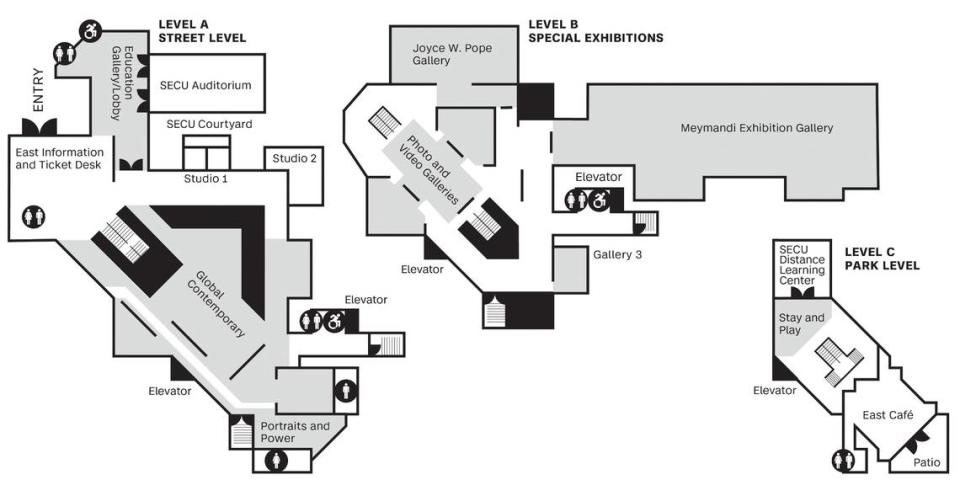NC Museum of Art’s reinstallation means pieces have moved around. Here’s a breakdown.
The reinstallation at the N.C. Museum of Art resulted in changes in both the older East Building and the newer West Building. Here’s what you’ll find:
West Building
▪ 20th-21st Century: These galleries encompass works from the early 1900s to the present day. The 20th-century collection focuses primarily on American painting but also includes sculpture, photography, prints, drawings and works by artists from other parts of the world. The 21st-century collection strives to present a global story of contemporary art with works in a wide variety of media by local, national and international artists.
▪ Art Conservation: This gallery showcases the study of art, science, history and technology as conservators share their understanding of the materials and techniques used to reconstruct and restore different types of objects. Rotating conservation projects will be featured, highlighting how artworks are researched, analyzed and preserved. The first is “Cloud Chamber for the Trees and Sky” by Chris Drury, which reopened in the Ann and Jim Goodnight Museum Park this year after extensive conservation.
▪ American: This new installation grapples with an evolving definition of American art and includes a variety of craft practices, decorative arts, printmaking and photography — media that have historically been more broadly accessible to women, people of color, indigenous makers and groups historically underrepresented in museums. For the first time, these galleries adjoin the museum’s ancient American collection, acknowledging the rich and innovative work created by cultures that thrived before European colonization in the 15th century.
▪ Ancient American: This gallery includes artifacts from 1150 B.C. to 1550 A.D. that cover a broad range of materials and functions and represent diverse cultures in Mexico, Guatemala, Belize, Honduras, Costa Rica and Peru. They include ceramic vessels, jewelry, statues, textiles and ritual objects from different periods and geographies.
▪ Audubon: The museum owns one of 134 known complete sets of John James Audubon’s four-volume masterwork “Birds of America,” which shaped the way we see birds and nature. In this new presentation, ornithologist and creative writer J. Drew Lanham examines these beautiful images in relation to Audubon’s place in art history.
▪ Rodin Court and Garden: In 2009 the Iris and B. Gerald Cantor Foundation donated 30 sculptures to the museum, making it the repository for the most extensive Rodin collection in the American South. The collection includes works from all phases of Rodin’s career, representing the depth and breadth of his work.
▪ Sculpture Court: The reinstalled Sculpture Court features a more dynamic display of the ancient marble sculptures and the Roman mosaic. The Statue of Bacchus, recently the subject of a major conservation project, is shown for the first time alongside these sculptures and is accompanied by an interactive learning station.

▪ European: The museum’s European collection spans centuries, from about 1150 through the early 1900s. The first three galleries explore art, society and Catholic devotion in paintings of the Middle Ages and Renaissance. Successive galleries examine the impact of a new medium — printing — on art and culture between the late 15th and early 16th centuries; collaborations between artists and patrons in the cities of Bologna and Venice; and 17th century Dutch and Flemish art, exploring the effects of the Dutch War of Independence and the development of painting genres.
▪ Judaic: The Judaic Art Gallery was founded in 1983 by Abram Kanof, a scholar of Jewish art, to illuminate the spiritual, cultural, and aesthetic heritage of the Jewish people through works of ceremonial art. The artworks in this gallery range over three centuries and four continents, embracing a variety of forms and artistic styles. Together they attest to the power of these objects in the service of faith and community.
▪ Ancient Greek, Italian and Roman: This collection covers more than 3,000 years of history, showcasing antiquities associated with food and drink in the ancient Mediterranean, the lives of women in Greek and Roman society, religious practice in a Roman home and funerary traditions from various cultures in this part of the world.
▪ Ancient Egyptian: Previously on view as two separate collections, this gallery is now connected to the African collection through a special thematic gallery called “The Africa We Ought to Know.” It celebrates that Africa is a continent where empires have flourished over millennia. Visitors can explore the continent and learn more about its people through interactive maps of trade routes and African kingdoms.
▪ African: Previously in the East Building, this collection presents the arts of Africa and its many diasporas in a new way. Highlighting a dynamically connected continent, they include arts of resistance and resilience, skillful works of named artists, and the power of the written and spoken word. They also include arts that reflect a spirit of individuality during Africa’s independence era; contemporary responses to African art histories and personal adornment, dress and design.
▪ Thematic gallery: In this new cross-collection gallery called “The Arts,” the broad spectrum of the arts will be presented through a variety of media, including moving images to foster understanding of creativity in new, vital ways. As museums continue to rethink what can be shown or expressed inside galleries, the integration of various art forms, including dance, music, theater and poetry, plays a key role in reimagining the museum experience.
▪ NCMA Cafe: Restaurant with a coffee bar, sandwiches and hot entrees such as shrimp and grits and fried chicken. Opening soon.

East Building
▪ Contemporary: The museum’s collection of contemporary art has swapped places with African art, which is now in the West Building.
▪ Portraits and Power: A new gallery that juxtaposes historic and contemporary portraits to show the power they convey.
Source: N.C. Museum of Art

 Yahoo Movies
Yahoo Movies 
